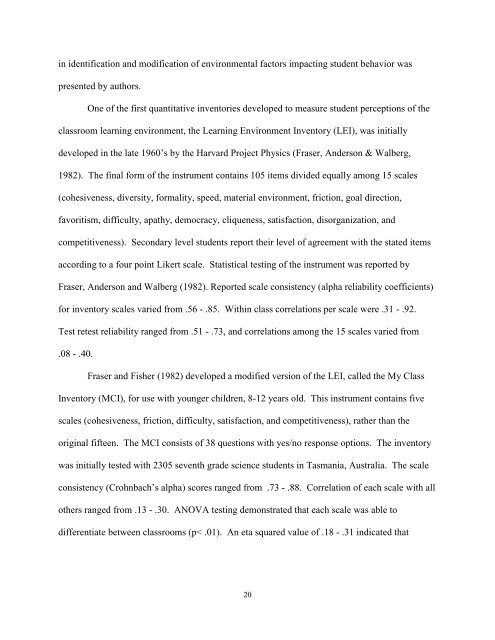STUDENT EVALUATION OF CLINICAL EDUCATION ENVIRONMENT
STUDENT EVALUATION OF CLINICAL EDUCATION ENVIRONMENT
STUDENT EVALUATION OF CLINICAL EDUCATION ENVIRONMENT
You also want an ePaper? Increase the reach of your titles
YUMPU automatically turns print PDFs into web optimized ePapers that Google loves.
in identification and modification of environmental factors impacting student behavior was<br />
presented by authors.<br />
One of the first quantitative inventories developed to measure student perceptions of the<br />
classroom learning environment, the Learning Environment Inventory (LEI), was initially<br />
developed in the late 1960’s by the Harvard Project Physics (Fraser, Anderson & Walberg,<br />
1982). The final form of the instrument contains 105 items divided equally among 15 scales<br />
(cohesiveness, diversity, formality, speed, material environment, friction, goal direction,<br />
favoritism, difficulty, apathy, democracy, cliqueness, satisfaction, disorganization, and<br />
competitiveness). Secondary level students report their level of agreement with the stated items<br />
according to a four point Likert scale. Statistical testing of the instrument was reported by<br />
Fraser, Anderson and Walberg (1982). Reported scale consistency (alpha reliability coefficients)<br />
for inventory scales varied from .56 - .85. Within class correlations per scale were .31 - .92.<br />
Test retest reliability ranged from .51 - .73, and correlations among the 15 scales varied from<br />
.08 - .40.<br />
Fraser and Fisher (1982) developed a modified version of the LEI, called the My Class<br />
Inventory (MCI), for use with younger children, 8-12 years old. This instrument contains five<br />
scales (cohesiveness, friction, difficulty, satisfaction, and competitiveness), rather than the<br />
original fifteen. The MCI consists of 38 questions with yes/no response options. The inventory<br />
was initially tested with 2305 seventh grade science students in Tasmania, Australia. The scale<br />
consistency (Crohnbach’s alpha) scores ranged from .73 - .88. Correlation of each scale with all<br />
others ranged from .13 - .30. ANOVA testing demonstrated that each scale was able to<br />
differentiate between classrooms (p< .01). An eta squared value of .18 - .31 indicated that<br />
20












